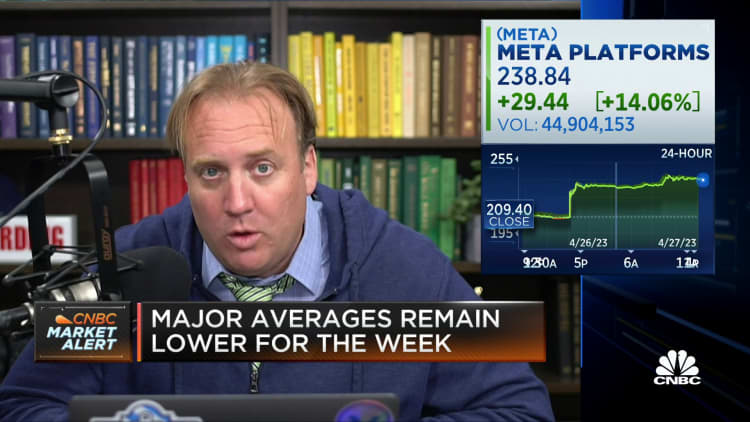[ad_1]
Andrew Ross Sorkin speaks with Meta CEO and founder Mark Zuckerberg during the New York Times DealBook Summit in the Appel Room at the Jazz At Lincoln Center on November 30, 2022 in New York City.
Michael M. Santiago | Getty Images
Meta is no longer the runaway growth story it was in the past, but you wouldn’t know that based on the stock chart in recent months.
On Wednesday, Facebook’s parent reported meager revenue growth of 3% from a year earlier, which was better than analysts were expecting. Before that, Meta had reported three straight quarters of sales declines, underscoring the social media company’s challenges coping with a slowdown in digital ads.
However, following a 15% rally on Thursday to over $241, Meta’s shares are up 170% since bottoming at under $89 in November.
For the most part, investors have been jumping on Meta’s cost-cutting story and two rounds of job reductions, which began in November and are continuing in the first half 2023. In February, CEO Mark Zuckerberg said this would be the company’s “year of efficiency,” a declaration that sent the stock up over 20%.
Even with the hot start to the year, Meta shares are still about 37% below their record high from September 2021. They lost two-thirds of their value last year, as the company reckoned with by far its toughest stretch since its IPO a decade earlier.
Now, Wall Street’s betting that Meta can slowly start to revive growth, with comparisons becoming easier after a weak year in 2022 and newer products beginning to show better traction.
The company continues pushing its TikTok-like Reels short-form video service, and finance chief Susan Li told analysts on Wednesday’s earnings call that the offering is “on track to becoming neutral to revenue by end of year, early next year.”
Reels currently monetizes at a slower pace than older and more established products like the news feed and Stories. Meta is figuring out how to better generate revenue from Reels and, at the same time, could be benefiting as TikTok, which is owned by the Chinese company ByteDance, faces heavy scrutiny from U.S. lawmakers, with many of them trying to ban the app.
Analysts at Mizuho Securities pointed to improved ad pricing as a significant catalyst for Meta, driven by Reels and messaging.
“With better monetization, additional room for cost efficiency, and increased scrutiny of TikTok, we continue to like the setup for FY23,” wrote the analysts, who recommend buying the stock.
Piper Sandler analysts, who also have a buy rating on the stock, said Meta is in a favorable revenue position for the rest of the year. They noted that “user growth remains strong” and said the business can keep expanding even with lower headcount.
“Meta successfully ‘passed the baton’ from cost cuts to revenue re-acceleration,” the analysts wrote.
As for Meta’s pivot to the nascent virtual world of the metaverse, the project continues to bleed cash. The Reality Labs division, responsible for developing software and hardware for the metaverse, lost $3.99 billion in the first quarter after losing $13.72 billion in 2022.
But there’s enthusiasm brewing for another growth market: artificial intelligence. Zuckerberg repeatedly emphasized his company’s investments in generative AI, which has been popularized by the text-generating ChatGPT tool developed by Microsoft-backed OpenAI.
Bank of America analysts said in a report that the buildout of an AI ecosystem could bolster Meta’s stock multiple.
“From a business perspective Meta outlined opportunities for AI enabled ad content creation and automated customer service using Meta’s messaging platforms,” wrote the analysts, who have a buy rating on the stock. “Multi-year AI driven platform retention could help multiple expansion, as terminal value uncertainty has weighed on valuation.”
Watch: Meta’s earnings reflect one of the best turnaround of all time.

[ad_2]
